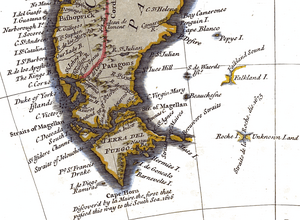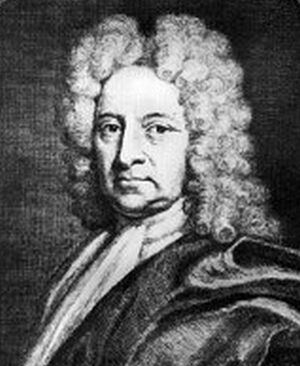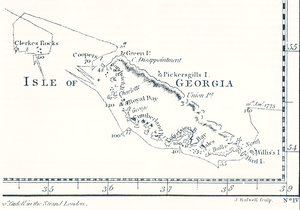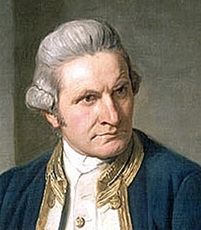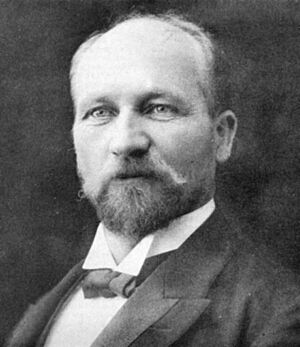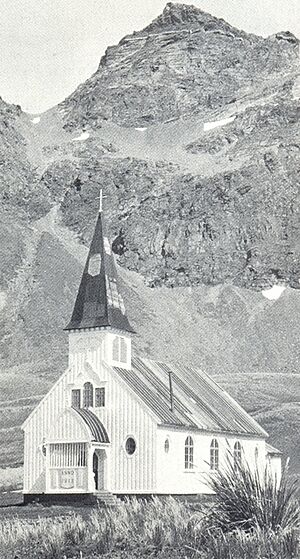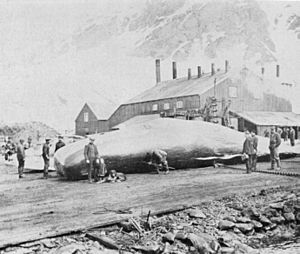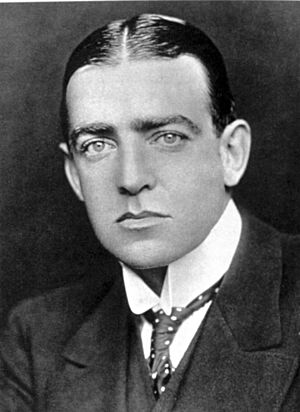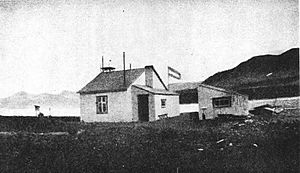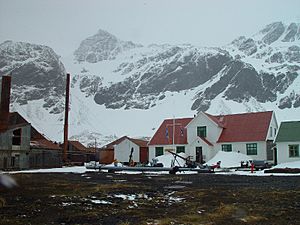History of South Georgia and the South Sandwich Islands facts for kids
The history of South Georgia and the South Sandwich Islands is quite recent. When European explorers first found these islands, no one lived there. Their very cold weather, mountains, and far-off location made it hard for people to settle. Because of these tough conditions, people mostly came to the islands for hunting seals, whaling, and doing scientific research. Two major events, World War II and the Falklands War, also played a part in their history.
|
|||||
| Motto: Leo Terram Propriam Protegat (Latin: Let the lion protect its own land) |
|||||
Contents
Early Discoveries and Explorers
South Georgia is an island in the South Atlantic. It was the first part of the Antarctic region to be discovered.
Some people think Amerigo Vespucci might have seen South Georgia in 1502. He described a cold, rough land where people couldn't live. However, experts now believe his records don't match South Georgia.
There was also a story about a mythical place called Pepys Island. English sailor William Cowley supposedly found it in 1683. But his notes show he was much too far away from South Georgia for it to be the same place.
The first confirmed discovery happened by accident. In April 1675, an English merchant named Anthony de la Roché was sailing when a big storm pushed his ship far off course. He found a safe bay in South Georgia and stayed there for 14 days. He wrote a report about his journey, and maps started showing "Roché Island" in his honor.
In 1700, Sir Edmond Halley explored the area around South Georgia. He was mapping magnetic fields in the South Atlantic. He came close to the island but mistook some large icebergs for land.
In 1756, a Spanish ship called León sighted the island and named it 'San Pedro'.
These early visits did not lead to any country claiming the land. Spain, for example, never claimed South Georgia.
The famous sailor Captain James Cook was the first to land on South Georgia. He also mapped the island. On January 17, 1775, he officially claimed it for Britain. He renamed it 'Isle of Georgia' after King George III. A naturalist with Cook, Georg Forster, wrote about the British flag being raised. Today, January 17 is celebrated as Possession Day in South Georgia.
The Shag Rocks and Black Rock are west of South Georgia. They were likely found in 1762 by a Spanish ship. They were later mapped by a British ship in 1920.
Many expeditions have surveyed South Georgia's coast and waters. From 1925 to 1951, the Discovery Committee did a lot of ocean research. They even discovered the Antarctic Convergence, a special ocean boundary. The first land-based scientific trip was a German expedition in 1882–83.
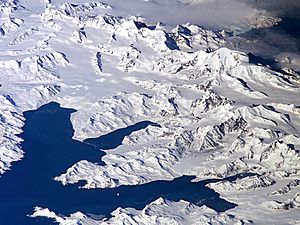
In the late 1700s and throughout the 1800s, English and American seal hunters lived on South Georgia. They sometimes stayed through the winter. The first fur seals were taken from the island in 1786.
Seal hunting was done in a way that was not sustainable. This meant they hunted so many seals that the fur seal population almost disappeared. Because of this, sealing had three main busy periods, with fewer seals hunted in between. Later, people started hunting elephant seals for their oil.
During the 1800s, Britain officially governed South Georgia. The island was part of the Falkland Islands Dependencies. This meant it was managed through the Falkland Islands but was a separate area. These arrangements lasted for a long time. In 1985, South Georgia and the South Sandwich Islands became their own British overseas territory.
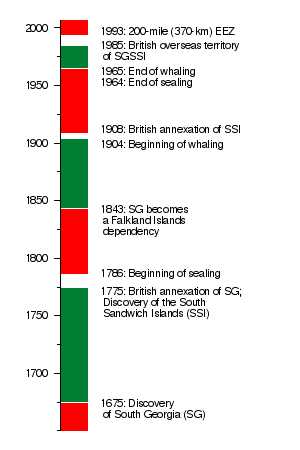
Whaling Era and British Rule
In the early 1900s, South Georgia became very busy again. The island was leased to a company, and whaling began at Grytviken in December 1904.
South Georgia became the world's biggest whaling center. There were shore bases at Grytviken, Leith Harbour, Ocean Harbour, Husvik, Stromness, and Prince Olav Harbour. Many different companies from various countries were involved in whaling here.
The spread of whaling to Antarctica led Norway to look for new territories. Britain stated that these areas were British, based on earlier discoveries. In 1908, Britain officially added the South Sandwich Islands to its possessions. These were listed as "Falkland Islands Dependencies." In 1909, a permanent British administration was set up in Grytviken.
All whaling stations in South Georgia operated with special permits from the British Governor of the Falkland Islands.
Carl Anton Larsen, who founded Grytviken, was a Norwegian who became a British citizen in 1910. He wrote that he had given up his Norwegian citizenship and wanted to live in the colony for a long time. His family lived with him in Grytviken.
Larsen organized the building of Grytviken. A team of 60 Norwegians built the whale oil factory, which started working on December 24, 1904. Larsen also set up a weather station there.
Larsen chose the Grytviken site during a visit in 1902. The name Grytviken means ‘Pot Cove’. This name was given by a Swedish archaeologist who found old pots used by sealers to boil seal oil. Larsen also brought reindeer to South Georgia in 1911 for the whalers to hunt.
Most whalers were Norwegian, but many Britons also worked there. The population was usually over 1,000 in summer and about 200 in winter. In 1909, a census showed 720 people, mostly Norwegian.
Managers often lived with their families. Solveig Gunbjörg Jacobsen was the first child born in Antarctica, on October 8, 1913, in Grytviken. Several other children were born on South Georgia.
There are about 200 graves on the island. One belongs to the famous explorer Sir Ernest Shackleton, who died in 1922. In 1916, Shackleton made an amazing journey across the Scotia Sea in a small boat to reach South Georgia. He then trekked across the island to get help for his crew, who were stranded after their ship sank.
Another explorer, Duncan Carse, mapped South Georgia between 1951 and 1957. His map is still used today.
A British official called a magistrate has lived in South Georgia since 1909, except for a short time in 1982. Britain's claim to the islands was sent to Argentina in 1909 and was accepted without objections at the time. Argentine ships visiting the island followed British rules.
During the Second World War, most whaling stations closed. German ships attacked some whaling vessels. The British officials on the island helped defend it. The Royal Navy placed guns at key points to protect Grytviken and Leith Harbour. Norwegian whalers volunteered to man these guns.
Sovereignty Dispute and the Falklands War
Argentina first officially claimed South Georgia in 1927. They claimed the South Sandwich Islands in 1938. Argentina has continued to claim these islands but has refused to let an international court decide the dispute.
On November 7, 1976, Argentina secretly built a naval station called Corbeta Uruguay on Thule Island in the South Sandwich Islands. Britain protested this. During the early stages of the Falklands War, Argentine special forces landed at Leith Harbour on South Georgia on March 25, 1982.
On April 3, 1982, Argentine ships attacked the 22 Royal Marines at Grytviken. The battle lasted two hours. The Argentine forces had three men killed and several wounded, while one British soldier was wounded. The British officer, Lieutenant Keith Mills, was honored for defending South Georgia. The British officials and military were removed from Grytviken. However, 15 other Britons remained hidden on the island. The losses suffered by Argentina at Grytviken stopped them from taking over the rest of the island.
On April 25, 1982, the Royal Navy damaged and captured an Argentine submarine near South Georgia. The Argentine soldiers in Grytviken surrendered without fighting back. The next day, the Argentine group in Leith Harbour also surrendered. Today, April 26 is celebrated as Liberation Day in South Georgia.
After the Argentine surrender at Grytviken, the British commander sent a famous message:
- "Be pleased to inform Her Majesty that the White Ensign flies alongside the Union Jack in South Georgia. God save the Queen."
Finally, on June 20, 1982, the Argentine personnel were removed from the South Sandwich Islands. Taking back South Georgia, which is very far away and has bad weather, was a big boost for Britain in the Falklands War.
The secret Argentine station on Thule Island was destroyed in January 1983.
After the Falklands War, Britain kept a small group of soldiers on South Georgia until March 2001. Then, the island returned to civilian rule. However, Argentina still claims South Georgia and the South Sandwich Islands.
Recent History
In 1985, South Georgia and the South Sandwich Islands became a separate British overseas territory. Before this, they were dependencies of the Falkland Islands.
Because of its far-off location and harsh climate, South Georgia had no native people when it was discovered. While people have lived on the island for the last two centuries, and some children have been born there, no families have stayed for more than one generation. Today, the main places where people live are Grytviken, King Edward Point, and Bird Island. King Edward Point is where ships enter, and it's home to the British Magistrate and other officials.
Since the 1990s, the islands have become a popular place for tourists, with cruise ships visiting regularly. To protect the unique environment, the government created the South Georgia and the South Sandwich Islands Marine Protection Area in 2012. This is one of the world's largest marine reserves.
South Sandwich Islands
The South Sandwich Islands are not inhabited and are even tougher to live on than South Georgia. They have active volcanoes. Since 1995, South Africa has kept two automatic weather stations on Zavodovski and Thule.
James Cook discovered the southern eight islands of the South Sandwich Group in 1775. He named them "Sandwich Land" after Lord Sandwich. The word "South" was added later to avoid confusion with "Sandwich Islands" (now Hawaii).
The northern three islands were discovered by Fabian Gottlieb von Bellingshausen in 1819. These islands include Candlemas, Vindication, Saunders, Montagu, Bristol, Bellingshausen, Cook, and Thule. The Traversay Islands (Zavodovski, Leskov, and Visokoi) were found by the Russian expedition of Bellingshausen and Lazarev in 1819.
The United Kingdom officially claimed the South Sandwich Islands in 1908. Argentina claimed them in 1938 and has challenged British rule many times. From 1976 to 1982, Argentina had a naval base called Corbeta Uruguay on Thule Island. Britain found out about the base in 1976 and protested. However, no force was used to remove them until after the Falklands War. The base was removed on June 20, 1982, and its buildings were destroyed in December.
Earthquakes sometimes happen in the region. A strong earthquake of magnitude 6.5 occurred in 2008, south-southeast of Bristol Island. Another one, magnitude 7.0, struck east-northeast of Bristol Island later that year.
Images for kids
See also
 In Spanish: Historia de las islas Georgias del Sur y Sandwich del Sur para niños
In Spanish: Historia de las islas Georgias del Sur y Sandwich del Sur para niños




